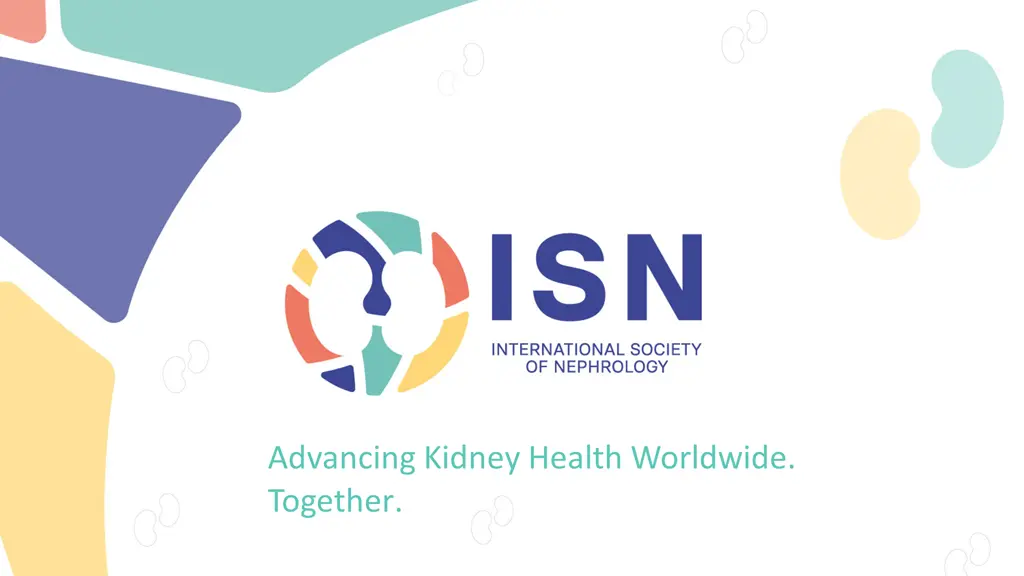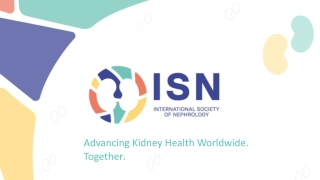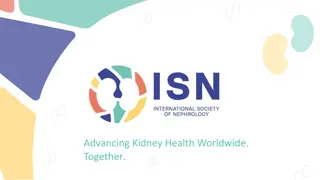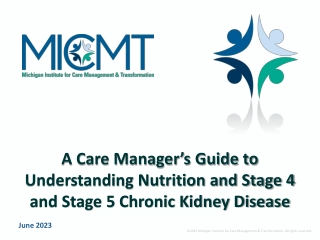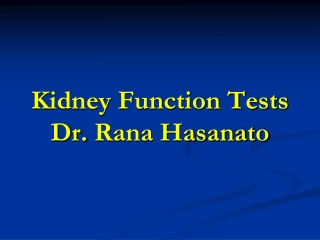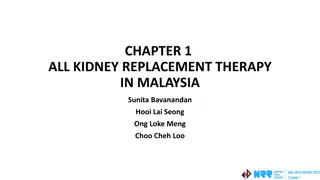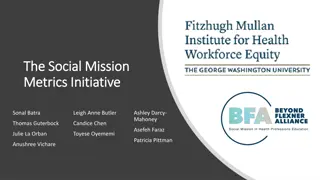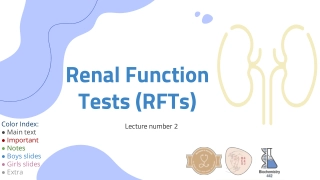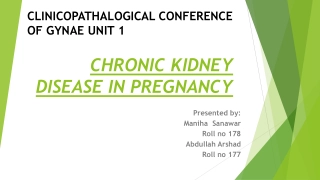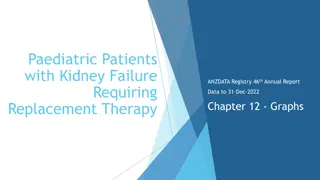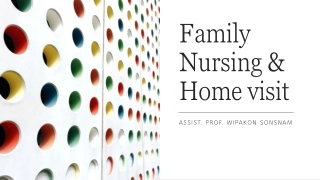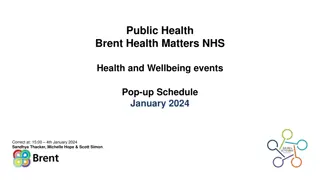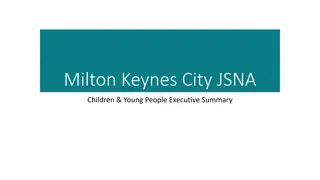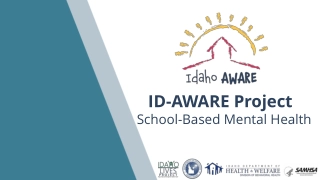Advancing Kidney Health Worldwide. Together.
Explore the 2023 ISN Global Kidney Health Atlas focusing on understanding, comparing, and monitoring kidney disease care worldwide. Learn about survey insights, research methods, and international responses for advancing kidney health.
Download Presentation
Please find below an Image/Link to download the presentation.
The content on the website is provided AS IS for your information and personal use only. It may not be sold, licensed, or shared on other websites without obtaining consent from the author. Download presentation by click this link. If you encounter any issues during the download, it is possible that the publisher has removed the file from their server.
Presentation Transcript
Advancing Kidney Health Worldwide. Together.
2023 ISN-GLOBAL KIDNEY HEALTH ATLAS (ISN-GKHA) ISN MIDDLE EAST REGION www.theisn.org/global-atlas July 2023 International Society of Nephrology 2
Overview Aim Methods Key Results July 2023 International Society of Nephrology 3
Aim of the ISN-Global Kidney Health Atlas To understand, compare and monitor how different countries around the world detect, treat, monitor and advocate for people with kidney disease (AKI or CKD). Key focus on availability, accessibility, affordability and quality of ESKD care July 2023 International Society of Nephrology 4
ISN-Global Kidney Health Atlas Survey 2016 2018 2022 2026 July 2023 International Society of Nephrology 5
Design and Scope Desk research (across countries and regions) Published and grey literature review Systematic review of kidney failure burden and outcomes Data extraction from major kidney registries (USRDS, ERA-EDTA) and relevant national registries where available Scoping review of KRT cost estimates Online questionnaire-based survey July September 2022 3 languages (English, French, Spanish) 191 countries contacted 3 stakeholders per country National nephrology society leadership Healthcare policymakers Patients / patient advocacy groups Discrepancies resolved by follow-up conferences with regional board chairs and country nephrology leaders July 2023 International Society of Nephrology 6
Overall Survey Components July 2023 International Society of Nephrology 7
Overall ISN-GKHA response 167 countries (92%) 97% world s population 329 individuals (63%) response 2 respondents/country (IQR 2-3) 108 countries participated in the 2017, 2019, and 2023 GKHA surveys July 2023 International Society of Nephrology 8
Results presented by ISN regions July 2023 International Society of Nephrology 9
ISN Region: The Middle East International Society of Nephrology 10 July 2023
Demographics Total health expenditures (% of GDP) Total population (2022) GDP (PPP) ($ billion) Country World bank ranking Area (sq km) 4 1,540,558 86,758,304 40,462,701 10,998,531 3,068,155 5,296,814 3,764,348 2,508,182 35,354,380 21,563,800 9,915,803 3,000,021 30,984,689 79.4 1449.3 428.6 113.0 Bahrain Iran, Islamic Rep. Iraq Jordan Kuwait Lebanon Oman Qatar Saudi Arabia Syrian Arab Republic United Arab Emirates West Bank and Gaza Yemen 760 High income 6.7 4.5 7.6 5.5 8.7 4.1 2.9 5.7 - 4.3 - 4.3 1,648,195 438,317 89,342 17,818 10,400 309,500 11,586 2,149,690 185,180 83,600 6,220 527,968 Lower-middle income Upper-middle income Upper-middle income High income Lower-middle income High income High income High income Low income High income Lower-middle income Low income 79.7 170.3 274.2 1751.2 717.5 30.5 : data not reported/unavailable Responses were received from 11 of 13 countries in Middle East (84.6%) representing 87% of the region s population. International Society of Nephrology 11 July 2023
Demographics Total health expenditures (% of GDP) Total Health Spending per person Government Health Spending per person Out-of-pocket Health Spending per person Total population (2022) GDP (PPP) ($ billion) Country World bank ranking Area (sq km) 4 1,540,558 86,758,304 40,462,701 10,998,531 3,068,155 5,296,814 3,764,348 2,508,182 35,354,380 21,563,800 9,915,803 3,000,021 30,984,689 79.4 1449.3 428.6 113.0 920 620 198 284 1413 326 565 1510 1230 42 1607 - 34 517 299 105 141 1273 150 499 1163 795 18 908 - 3 282 224 92 86 126 110 32 121 157 17 180 - 22 Bahrain Iran, Islamic Rep. Iraq Jordan Kuwait Lebanon Oman Qatar Saudi Arabia Syrian Arab Republic United Arab Emirates West Bank and Gaza Yemen 760 High income 6.7 4.5 7.6 5.5 8.7 4.1 2.9 5.7 - 4.3 - 4.3 1,648,195 438,317 89,342 17,818 10,400 309,500 11,586 2,149,690 185,180 83,600 6,220 527,968 Lower-middle income Upper-middle income Upper-middle income High income Lower-middle income High income High income High income Low income High income Lower-middle income Low income 79.7 170.3 274.2 1751.2 717.5 30.5 : data not reported/unavailable July 2023 International Society of Nephrology 12
CKD and its risk factors burden CKD Prevalence % (95% CI) Death attributed to CKD % (95% CI) DALYS attributed to CKD % (95% CI) Obesity % (95% CI) Increased BP % (95% CI) Country 9.31 (8.59 - 10.05) 4.13 (3.62 - 4.74) 2.2 (1.87 - 2.57) Bahrain 28.7 (23.5 - 34.2) 21.4 (15.7 - 27.8) 10.37 (9.70 - 11.02) 3.21 (2.92 - 3.4) 1.81 (1.62 - 1.99) Iran, Islamic Rep. 25.5 (22.2 - 28.9) 19.7 (15.2 - 24.6) 7.76 (7.21 - 8.29) 4.39 (3.77 - 5.23) 2.44 (2.06 - 2.86) Iraq 27.4 (22.7 - 32.4) 25.2 (19.1 - 31.6) 7.84 (7.34 - 8.35) 5.62 (5.02 - 6.18) 2.67 (2.34 - 3.03) Jordan 33.4 (29.0 - 37.9) 21.0 (15.8 - 26.9) 8.48 (7.81 - 9.14) 3.22 (2.78 - 3.66) 1.59 (1.35 - 1.86) Kuwait 37.0 (32.2 - 42.0) 23.6 (17.9 - 30.0) 12.23 (11.42 - 13.02) 3.49 (2.58 - 4.58) 2.22 (1.76 - 2.77) Lebanon 31.3 (26.2 - 36.6) 20.7 (15.4 - 26.8) 6.33 (5.81 - 6.87) 1.61 (1.4 - 1.84) 1.11 (0.96 - 1.29) Oman 22.9 (18.3 - 27.9) 24.8 (18.9 - 31.5) 6.80 (6.21 - 7.46) 3 (2.68 - 3.38) 1.5 (1.25 - 1.76) Qatar 33.9 (27.7 - 40.5) 22.4 (16.1 - 29.8) 8.47 (7.85 - 9.09) 5.4 (4.63 - 6.08) 3 (2.53 - 3.46) Saudi Arabia 35.0 (30.5 - 39.5) 23.3 (18.0 - 29.2) 9.33 (8.72 - 9.98) 3.15 (2.81 - 3.44) 2.13 (1.87 - 2.38) Syrian Arab Republic 25.8 (20.7 - 31.3) 24.5 (18.7 - 30.8) 7.87 (7.18 - 8.57) 4.92 (3.67 - 7.36) 3.07 (2.32 - 4.47) United Arab Emirates 29.9 (24.0 - 36.0) 21.1 (15.2 - 28.0) - - - West Bank and Gaza - - 14.1 (10.8 - 17.8) 30.7 (23.3 - 38.7) 4.92 (4.55 - 5.33) 1.53 (1.26 - 1.88) 0.88 (0.75 - 1.03) Yemen Abbreviations: CKD (Chronic Kidney Disease), DALYS (disability-adjusted life years), BP (blood pressure), CI (confidence interval) Data source: GBD study database (http://www.healthdata.org/gbd), WHO data observatory (https://www.who.int/gho/en/) : data not reported/unavailable July 2023 International Society of Nephrology 13
Burden of kidney failure Prevalence of treated kidney failure Treated kidney failure Chronic dialysis (HD+PD) Chronic Hemodialysis Chronic Peritoneal dialysis Country Incidence Prevalence Incidence Prevalence Incidence Prevalence Incidence Prevalence Bahrain 207.5 339.7 - 250.2 - - - - Iran, Islamic Rep. 81 654 - 343 - 211.4 - 17.6 Iraq - 251 - 145 - - - - Jordan - - - 446.3 - 428.9 - 17.4 Kuwait 142 869 - 467 - 417.12 - 52.14 Lebanon - - - 694 - 668.5 - 25.5 Oman 120 670 - 358 - 250 - 10.9 Qatar 164 645 - 366 - 303.15 - 64.5 Saudi Arabia 145 826 - 557 - 409.5 - 35 Syrian Arab Republic - - - 155.1 - 149.1 - 6 United Arab Emirates - 152 - 201.4 - 184.1 - 17.3 West Bank and Gaza - - - - - - - - Yemen - - - 108.4 - 99.1 - 9.3 * pmp (per million population) Data source: Alalawi et al. (Saudi J Kidney Dis Transpl.) 2017, Jain et al. (JASN) 2012, 2019 USRDS Annual Data Report : data not reported/unavailable Treated kidney failure: all dialysis + transplant July 2023 International Society of Nephrology 14
Burden of kidney failure (contd) Kidney transplantation Incidence of kidney transplantation Country Incidence of deceased donor Incidence of living donor Incidence of pre- emptive Incidence overall Prevalence overall - 52.7 - - - Bahrain 14.76 311 9.76 5 - Iran, Islamic Rep. - 106 - - - Iraq 10 - 0.1 9.9 - Jordan 20.23 402 9.07 11.16 - Kuwait 12.88 1.02 11.86 - Lebanon 2.22 279 0 2.22 - Oman 16.55 279 5.86 10.69 - Qatar 29.58 269 2.58 27 - Saudi Arabia 17.21 - 0 17.21 - Syrian Arab Republic 13 - 6.6 6.4 - United Arab Emirates - - - - - West Bank and Gaza - 52.7 - - - Yemen * pmp (per million population) Data source: GODT database (http://www.transplant-observatory.org/data-charts-and-tables/), 2019 USRDS Annual Data Report : data not reported/unavailable July 2023 International Society of Nephrology 15
Annual cost of KRT Kidney Transplant (First year) Kidney Transplant (later years) Country Hemodialysis Peritoneal dialysis HD/PD ratio - - - - - Bahrain 46115.53 47404.51 11845.52 - 0.972809 Iran, Islamic Rep. - - - - - Iraq - - - - - Jordan 34481.28 16135.47 156050.4 16663.28 2.136986 Kuwait 13392.09 - - - - Lebanon 65587.37 109721.2 - - 0.597764 Oman 17970.89 - 18185.4 3307.05 - Qatar - - - - - Saudi Arabia 6375 - 8950 4150 - Syrian Arab Republic - - - - - United Arab Emirates 5603.21 7502.99 - - 0.746797 West Bank and Gaza 6493.97 11122.42 9823.85 1240 0.583863 Yemen *Cost is in $US 2021 Abbreviations: HD (hemodialysis), PD (peritoneal dialysis) Data source: Al Arrayed et al. (2000), Al-Jedai et al. (2012), Aoun et al. (2022), Batieha et al. (2007), Moradpour et al. (2020), Sekkarie et al. (2015), van der Tol et al. (2019), Younis et al. (2015) : data not reported/unavailable July 2023 International Society of Nephrology 16
Country level scorecard Availability of Distribution of Registry Nephrology Workforce (PMP) Availability of KRT Availability of CKM Funding for Medications Advocacy Group Choice restricted Choice restricted Shared decision transplantation transplantation transplantation Nephrologist Nephrologist (not limited) Country (limited) trainees Kidney Kidney Kidney Dialysis Dialysis CKD CKD CKD RRT AKI AKI HD PD 2019 2023 2019 2023 2019 2023 2019 2023 2019 2023 2019 2023 2019 2023 2019 2023 2019 2023 2019 2023 2019 2023 4.97 4.84 2.49 2.72 8.08 11.91 10.29 48.89 28.28 36.81 20.03 39.85 15.87 23.92 8.46 19.80 5.14 4.64 6.70 0.35 0.23 1.00 0.69 1.82 2.09 24.00 0.33 2.05 2.27 2.86 1.59 2.12 1.99 15.94 1.56 1.03 0.93 0.72 0.50 0.00 0.33 Iran, Islamic Rep. Iraq Jordan Kuwait Lebanon Oman Qatar Saudi Arabia Syrian Arab Republic United Arab Emirates 3.04 5.00 West Bank and Gaza Abbreviations KRT: kidney replacement therapy CKM: conservative kidney management CKD: chronic kidney disease AKI: acute kidney injury RRT: renal replacement therapy Yes No N/A July 2023 17 International Society of Nephrology
Funding for non-dialysis CKD Publicly funded by govt but with some fees at the point of delivery Solely private through health insurance Publicly funded by govt; free at the point of delivery Mix of public and private funding systems Solely private and out-of- pocket Multiple systems Country Other Iran, Islamic Rep. X Iraq X Jordan X Kuwait X Lebanon X Oman X Qatar X Saudi Arabia X Syrian Arab Republic X United Arab Emirates X West Bank and Gaza X X : Yes July 2023 International Society of Nephrology 18
Funding for kidney replacement therapy (KRT) Solely private (health insurance) Multiple systems Publicly funded (some fees) Solely private (out-of- pocket) Publicly funded (free) Mixed N/A Other Country AKI HD PD TX AKI HD PD TX AKI HD PD TX AKI HD PD TX AKI HD PD TX AKI HD PD TX AKI HD PD TX AKI HD PD TX Iran, Islamic Rep. X X X X Iraq X X X X Jordan X X X X Kuwait X X X X Lebanon X X X X Oman X X X X Qatar X X X X Saudi Arabia X X X X Syrian Arab Republic X X X X United Arab Emirates X X X X West Bank and Gaza X X X X X : Yes Abbreviations: AKI (Acute kidney injury), HD (hemodialysis), PD (peritoneal dialysis), TX (transplant medications) July 2023 International Society of Nephrology 19
Providers primarily responsible for kidney failure care Primary care physicians Nurse Specialized nurses Multidisciplinary teams Country Nephrologists Other practitioners Iran, Islamic Rep. X Iraq X Jordan X Kuwait X Lebanon X Oman X Qatar X Saudi Arabia X Syrian Arab Republic United Arab Emirates West Bank and Gaza X X X X : Yes July 2023 International Society of Nephrology 20
Shortage of kidney failure care providers Pediatric nephrologists Transplant surgeons Surgeons (HD access) Surgeons (PD access) Laboratory technicians Radiologists (ultrasound) Vascular access coordinators Country Nephrologists Dietitians Iran, Islamic Rep. Iraq Jordan Kuwait Lebanon Oman Qatar Saudi Arabia Syrian Arab Republic United Arab Emirates West Bank and Gaza No shortage Shortage July 2023 International Society of Nephrology 21
Shortage of kidney failure care providers Kidney Counsellors/ psychologists Transplant coordinators Dialysis technicians Palliative care physicians Country Dialysis nurses Renal nurses Social workers supportive care nurses No shortage Iran, Islamic Rep. Iraq Jordan Kuwait Lebanon Oman Qatar Saudi Arabia Syrian Arab Republic United Arab Emirates West Bank and Gaza No shortage Shortage July 2023 International Society of Nephrology 22
Prevalence of nephrologists and trainees Nephrologists Nephrologists PMP Nephrology trainees PMP Country 4.84 0.23 Iran, Islamic Rep. 2.72 0.69 Iraq 11.91 2.09 Jordan 48.89 0.33 Kuwait 36.81 2.27 Lebanon 39.85 1.59 Oman 23.92 1.99 Qatar 19.80 1.56 Saudi Arabia 4.64 0.93 Syrian Arab Republic - 0.50 United Arab Emirates 5.00 0.33 West Bank and Gaza July 2023 International Society of Nephrology 23
Capacity for chronic dialysis (HD) Chronic HD centers Chronic HD Centres PMP Country 7.47 Iran, Islamic Rep. 0.64 Iraq 7.91 Jordan Chronic HD services are available in all countries of the region 3.26 Kuwait 15.10 Lebanon The Middle East average of HD treatment centers is 5.03 pmp 6.64 Oman 2.39 Qatar 5.66 Saudi Arabia 2.55 Syrian Arab Republic 1.01 United Arab Emirates 2.67 West Bank and Gaza : data not reported/unavailable July 2023 International Society of Nephrology 24
Capacity for chronic dialysis (PD) Chronic PD Centres PMP Chronic PD centers Country 0.35 Iran, Islamic Rep. 0.07 Iraq 0.55 Jordan Chronic PD services are available in all countries of the region 3.26 Kuwait 0.94 Lebanon The Middle East average of PD treatment centers is 0.99 pmp 2.66 Oman 1.20 Qatar 0.71 Saudi Arabia 0.32 Syrian Arab Republic 0.50 United Arab Emirates 0.33 West Bank and Gaza : data not reported/unavailable July 2023 International Society of Nephrology 25
Capacity for Kidney transplantation Kidney Kidney transplantation centers Transplant centers PMP Country Transplantation availability 0.30 Iran, Islamic Rep. X 0.15 Iraq X Kidney transplantation services are available in all countries of the region 1.55 Jordan X 0.33 Kuwait X 0.94 Lebanon X 0.53 Oman X The Middle East average of Kidney transplantation centers is 0.52 pmp 0.40 Qatar X 0.28 Saudi Arabia X 0.28 Syrian Arab Republic X 0.61 United Arab Emirates X 0.33 West Bank and Gaza X X : Yes July 2023 International Society of Nephrology 26
Capacity for Kidney transplantation (contd) Transplant donor type Transplant waitlist Donor type Transplant waitlist Country Regional only Live donors only Combination None National Iran, Islamic Rep. X X X X Iraq Jordan X X Kuwait X X Lebanon X X Oman X X Qatar X X Saudi Arabia X X Syrian Arab Republic X X United Arab Emirates X X West Bank and Gaza X X X : Yes July 2023 International Society of Nephrology 27
Availability of services within dialysis care HD frequency PD frequency HD frequency ability to do adequate exchanges 3-4x day (or equivalent cycles on automated PD) a center-based service that involves treatment 3x week/3-4x hours Country N/A (dialysis not provided) N/A (dialysis not provided) Generally not available Generally not available Generally available Generally available Never Unknown Never Unknown Iran, Islamic Rep. X X Iraq X X Jordan X X Kuwait X X Lebanon X X PD frequency Oman X X Qatar X X Saudi Arabia X X Syrian Arab Republic X X United Arab Emirates X X West Bank and Gaza X X X : Yes July 2023 International Society of Nephrology 28
Availability of Home hemodialysis Availability of Home hemodialysis N/A (dialysis not provided) Generally not available Country Generally available Never Unknown Iran, Islamic Rep. X Iraq X Jordan X Kuwait X Lebanon X Oman X Qatar X Saudi Arabia X Syrian Arab Republic X United Arab Emirates X West Bank and Gaza X X : Yes July 2023 International Society of Nephrology 29
Capacity for conservative kidney management (CKM) Established conservative care that is chosen or medically advised N/A Country Generally available Generally not available (conservative care not available) Unknown Iran, Islamic Rep. X Iraq X Jordan X Kuwait X Lebanon X Oman X Qatar X Saudi Arabia X Syrian Arab Republic X United Arab Emirates X West Bank and Gaza X X : Yes July 2023 International Society of Nephrology 30
Capacity for conservative kidney management (CKM) Where resource constraints to prevent or limit access to KRT where resource constraints to prevent or limit access to KRT where there are no resource constraints to prevent or limit access to KRT N/A N/A Country Generally not available Generally not available Generally available (conservative care not available) Generally available (conservative care not available) Unknown Unknown Iran, Islamic Rep. X X Iraq X X Jordan X X Kuwait X X Lebanon X X Oman X X Qatar X X Where there are no resource constraints to prevent or limit access to KRT Saudi Arabia X X Syrian Arab Republic X X United Arab Emirates X X West Bank and Gaza X X X : Yes July 2023 International Society of Nephrology 31
Funding for medications in CKD patients not on dialysis Publicly funded by govtbut with some fees at the point of delivery Publicly funded by govt; free at the point of delivery Solely private through health insurance providers Mix of public and private funding systems Solely private and out-of- pocket Multiple systems Country Other Iran, Islamic Rep. X Iraq X Jordan X Kuwait X Lebanon X Oman X Qatar X Saudi Arabia X Syrian Arab Republic X United Arab Emirates X West Bank and Gaza X X : Yes July 2023 International Society of Nephrology 32
Funding for medications in all dialysis patients Publicly funded by govtbut with some fees at the point of delivery Publicly funded by govt; free at the point of delivery Solely private through health insurance providers Mix of public and private funding systems Solely private and out-of- pocket Multiple systems Country Other Iran, Islamic Rep. X Iraq X Jordan X Kuwait X Lebanon X Oman X Qatar X Saudi Arabia X Syrian Arab Republic X United Arab Emirates X West Bank and Gaza X X : Yes July 2023 International Society of Nephrology 33
Funding for medications in all transplant patients Publicly funded by govtbut with some fees at the point of delivery Publicly funded by govt; free at the point of delivery Solely private through health insurance providers Mix of public and private funding systems Solely private and out-of- pocket Multiple systems Country Other Iran, Islamic Rep. X Iraq X Jordan X Kuwait X Lebanon X Oman X Qatar X Saudi Arabia X Syrian Arab Republic X United Arab Emirates X West Bank and Gaza X X : Yes July 2023 International Society of Nephrology 34
Availability of official registry Official Registry Country CKD Dialysis Transplant AKI Conservative care Iran, Islamic Rep. X X Iraq X Jordan X X Kuwait X X Lebanon X Oman X X X X Qatar X X Saudi Arabia X X Syrian Arab Republic United Arab Emirates West Bank and Gaza X : Yes July 2023 International Society of Nephrology 35
Summary of Findings In summary, the 2023 ISN-GKHA highlights several important findings for the Middle East. KRT availability, access, and quality is high. o HD and PD services are available in all countries in the region. o Capacity to provide adequate frequency of HD i.e., three times weekly for 3 4 hours per session, was available in 10 (91%) of countries in the region. o Capacity to provide adequate PD exchanges i.e., three to four exchanges per day was available in 8 (73%) countries. o Home HD was available in 3 (27%) (Qatar, Saudi Arabia, and UAE). o KT centres are available in all countries in the region with a median prevalence of 0.33 pmp CKM is available and predominately chosen or medically advised. o CKM established through shared-decision making was available in 5 (45%) countries. o Choice restricted CKM (where resource constraints prevent or limit access) was available in 3 (27%) countries. o Choice restricted CKM (where no resource constraints prevent or limit access) was available in 2 (18%) countries. Government funding for kidney care services and medication is low. o Reimbursement for medications that is free at point of delivery for ND-CKD, dialysis, and KT are available in 4 (36%), 5 (45%), and in 8 (72.7%) countries, respectively. o Reimbursement that is free for acute dialysis, chronic HD, and chronic PD were available in 6 (54.5%), 8 (72.7%), and 6 (54.5%) countries, respectively. July 2023 International Society of Nephrology 36
Summary of Findings (contd) Most have registries for advanced kidney disease, few for CKD or AKI o Availability of kidney registries varied across countries in the region. o ND-CKD registry was available only in Oman; dialysis registries in 6 (54.5%), and KT registries are available in 8 (72.7%) countries in the region. Acute dialysis registries are not available in the region and only Oman reported having a CKM registry. Many workforce limitations are present. o The median prevalence of nephrologists was 15.9 pmp with the highest prevalence in Kuwait (48.9 pmp) and the lowest in Iraq (2.7 pmp). o The median prevalence of nephrology trainees in the region was 0.93 pmp and was highest in Lebanon (2.3 pmp) and lowest in Iran (0.23 pmp). o More than half of countries in the region reported shortages of paediatric nephrologists (55%), transplant surgeons (64%), surgeons or interventional radiologists for AVF/AVG creation (64%) and PD catheter insertion (64%), dialysis nurses (55%), social workers (55%), and kidney supportive care nurses (55%). Moderate advocacy for kidney disease in the Middle East. o Advocacy groups for CKD, kidney failure and KRT remains low in the region. July 2023 International Society of Nephrology 37
Implications There are important implications to consider. Based on these survey findings, key recommendations to drive future activities for optimizing kidney care globally are proposed: Increase health care financing for kidney failure prevention and management. o While resource limitations are an obvious barrier, focusing on preventing kidney failure through appropriate hypertension and diabetes management may be more cost-effective overall. Government funding to cover medication costs may allow more patients to treat earlier stage CKD, thereby preventing the need for more costly kidney failure treatment and the obvious burden this has on patients wellbeing. Address workforce shortages through multidisciplinary teams and telemedicine o Shortages of nephrologists, surgeons, dialysis nurses, and other key allied health professionals were noted across most countries. Similarly, simply producing more nephrologists may not be feasible or appropriate, and sharing the workload across multiple providers will not only promote the use of multidisciplinary teams but further, allow for more and better care delivery across more patients. Telemedicine may help particularly in addressing gaps in care among rural patients and enhancing capacity through training programs such as ISN Fellowship, visiting ambassador programs, etc. July 2023 International Society of Nephrology 38
Implications (contd) Incorporate the collection and reporting of quality indicators in kidney failure care. o Measuring and reporting on key quality indicators is an important driver in healthcare improvement. Ensuring facilities are supported with information systems that allow for the systematic measurement and reporting of indicators is a first key step to increasing the rate of monitoring among countries. Further, understanding if or how the collection and reporting of indicators are being used to improve care is needed. Expand health information systems to prevent and manage kidney failure. o Similarly, good quality HIS are vital for kidney disease management within a country. A lack of data on disease prevalence, incidence, resource use, and quality of care limits government and provider ability to monitor and evaluate the care provided as well as predicts appropriate resource allocation so that sufficient facilities, medicines, and healthcare professionals are trained and available. Promote kidney failure prevention and treatment by implementing policies, strategies, and advocacy, and mitigating barriers. o Lastly, policies and strategies are important for consistent approaches within a country for optimal care delivery, as well as for accountability, leadership, and knowledge exchange. Advocacy may help promote the increase of government prioritization and further, public awareness of how to prevent and manage kidney disease. Without acknowledging and mitigating barriers, it would be a challenge to achieve of successes out of these recommendations. Competing priorities and needs (for example, clean water supply and basic sanitation, maternal and child health, malnutrition, etc.) represent formidable barriers that can limit implementation of the recommended strategies in the region. July 2023 International Society of Nephrology 39
www.theisn.org Global Operations Center Americas Operations Center Avenue des Arts 1-2 1210 Brussels, Belgium 340 North Avenue 3rd Floor Cranford, NJ 07016-2496, United States +1 904 345 0866 +32 2 808 04 20 info@theisn.org info@theisn.org Follow us
